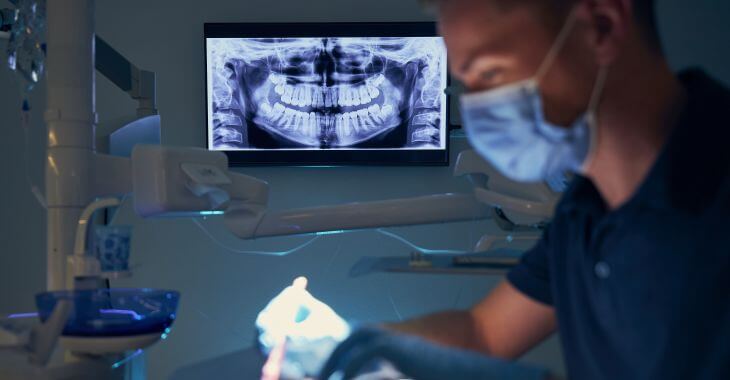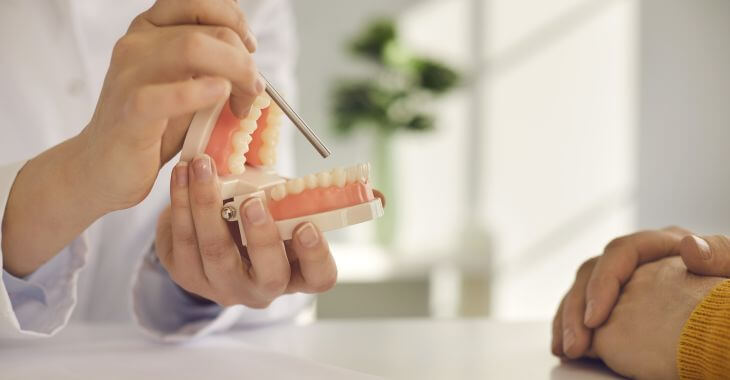What to Expect After Dental Bone Graft Surgery

The jawbones are the foundation for your teeth and your lower facial structure. When bone loss occurs in the jawbones, it can result in tooth loss (it can also be caused by tooth loss, so it is a vicious cycle), and it may impact the facial appearance. To restore jawbone density, a dental bone graft can be used to stimulate bone growth. This is most commonly performed before dental implant surgery to strengthen the jaw to support a new dental implant. Here is what you need to know about bone grafts and what to expect after dental bone graft surgery.
Bone loss in the jawbones is common. Periodontal disease is one of the biggest contributors to bone loss, which can lead to lost teeth. Once a tooth is diseased, broken or removed, the bone around the root socket quickly begins to deteriorate. If a dental implant is desired to replace a single tooth or to support bridges or dentures for multiple tooth loss, there must be enough bone to support the implant or implants. A dental bone graft can increase bone density to allow for dental implant surgery.
How Is a Dental Bone Graft Performed?
A bone graft uses bone or simulated material to increase bone density. There are multiple options in bone graft materials. Bone can be harvested from the patient’s own bones, which is called an autograft. Human bone from a cadaver can be used, which is called an allograft. A xenograft uses animal bone, while an alloplastic graft uses a synthetic bone material. All can be used in a dental bone graft, each with pros and cons.
Dental bone grafts are oral surgery and require access through the gum tissue to reach the jawbone. If a tooth is extracted and a dental implant will replace it, a bone graft can be completed at the time of extraction and inserted into the open socket. If the tooth or teeth are already gone, an incision is made into the gum tissue to access the jaw. Once the bone graft is complete, the gum tissue is stitched closed. This begins the recovery and healing process between the dental bone graft and dental implant surgery.
What to Expect After a Dental Bone Graft
You can expect to need a few days to recover after a dental bone graft procedure. While it is a minor surgery, you want to allow the area to heal to prevent infection or any other type of complication. Most dentists and their dental team will tell patients what to expect after dental bone graft surgery and instructions for recovery. However, to help you prepare for your surgery, this is what you can expect after your procedure.
- Some Discomfort and Swelling
- Once the local anesthesia dissipates, you will feel some pain and discomfort at the surgical site. The good news is that most patients report minimal discomfort that can be controlled with pain relievers – your dentist will tell you which medications you can use. There also will be swelling, which NSAIDS can help reduce, as well as combatting discomfort. You can also use an ice pack to reduce swelling and pain.
- Sleep Positions
- Your dentist will likely recommend that you prop your head up on two or more pillows and sleep on your back for a few days after your dental bone graft. It is best to avoid laying on the side of the face where the surgery occurred until it has healed.
- Food Restrictions
- Like most oral surgery, dental bone grafting recovery requires some food restrictions. Your dentist will want you to avoid chewing crunchy or hard foods for a few days while the gum tissue heals. Each patient may have different food restrictions, depending on the type and extent of their dental bone graft surgery.
- You may be asked to only consume liquids like soup or juice for a day or more for more invasive surgery; minor bone graft patients may be able to consume some soft foods like yogurt, oatmeal or mashed potatoes. The food restrictions are only for a few days while the surgical site initially heals.
- Take It Easy and Rest
- It is important to allow your body to rest and heal after any oral surgery, including a dental bone graft. Avoid strenuous physical activity for a few days after your procedure to give your body a chance to recover. Most people can perform normal daily tasks and non-strenuous work in one to two days.

If you have bone loss in the jaw from tooth loss or periodontal disease, a bone graft can help increase your bone density and allow for dental restorations like dental implants. Now you know what to expect after bone graft surgery and the best ways to improve your recovery and healing process. Make sure to follow your dentist’s specific post-surgery instructions to avoid any unnecessary complications.
The information provided on this website, including text, graphics, images, and other materials, is intended solely for informational purposes and should not be used as a substitute for professional medical advice, diagnosis, or treatment.



)